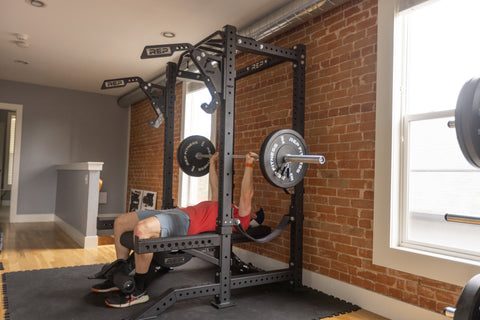
Whether you’re building an home gym or beefing up a commercial gym, start at the heart: with a power rack or rig. Think of this piece of equipment as the central framework you can build off of for years to come.
Both racks and rigs are large, metal structures with pinholes that you can attach things to and pull-up bars/connector bars you can use for bodyweight exercises or as attachment points. Both racks and rigs are highly versatile, built to handle heavy loads, can add order to your workout space, and can help keep you safe during barbell exercises (both are compatible with Spotter Arms). You can add Weight Horns to both racks and rigs to organize weight plates up off the floor, too.
However, while a rack and rig share many functions, they’re not the same.
What’s a Rack?

There are several types of racks:
- A power rack is a metal, cage-like piece of weight-training equipment. Not only can it be used for a wide range of barbell lifts (squats, bench press, rack pulls, etc.), but it also is compatible with tons of accessories for other exercises and safety. A power rack typically consists of a set of (4) uprights, set of (4) crossmembers (pair for a rack with a "flat foot base"), a top crossmember, and a pull-up bar. It's a stable, heavy-duty option.
- A squat rack/stand is a steel piece of equipment that can support the bar before and after squats, but with fewer "uprights" so it does not create a cage-like space.
- A half rack is a smaller, more compact version of a power rack. It's still compatible with attachments. You typically work outside of the rack instead of inside of the cage, like with a power rack.
How is a Rig Different Than a Rack?

Then there is a rig. A rig is a training station that comes in various sizes and can be enhanced with various attachments – think of it like an oversized, open power rack. Rigs are bolted to the ground or wall, and multiple stations can be connected to save space.
Power racks do not necessarily have to be bolted in place (you can add features like Front Foot Extensions to keep a rack balanced without needing to bolt it down). You don’t connect multiple power racks together; they’re more like independent work stations. In that, a power rack provides more privacy, and a rig is ideal for team workouts. Whereas a rack has just one lifting station (think: squats), a rig is modular, so you can add and subtract stations, as needed. In that, rigs are incredibly versatile.
A training rig is most commonly found in a commercial setting -- although you could put one in your home gym if you have the space and ceiling height. Rigs are typically taller: 108” or 9’, compared with a power rack at 80” or 6.67’ for a shorter rack or 93” or 7.75’ for a standard rack.
A rig also tends to be simpler. Power racks, especially the premium, 5000 Series racks, can be more customized and detailed, with tons of color options, different pull-up bar styles, and more attachment options than rigs. For example, you can add an on-rack cable machine to a power rack (see: Athena™ attachment, Ares™ attachment, and Lat/Low Row Attachment), but these aren’t compatible with a rig.
Should I Get a Rig or Rack?

If you are looking for a lifting station for your home gym where only one person will be training at a time; you have typical, household ceiling heights; you want an on-rack cable attachment; prefer safeties over spotter arms (safer due to having two points of contact and you can't miss them); and/or you don’t have a ton of extra space, a power rack is likely your best bet.
If you’re building out a commercial gym or group lifting space where you need ultimate versatility; need to accommodate multiple lifters at once; don’t need on-rack cables or have space for a stand-alone functional trainer; want to have more expansion options; and/or you want to maximize working space, consider a rig.

NEWSLETTER SIGNUP
Product launch information, promotions, blogs, and REP news.







